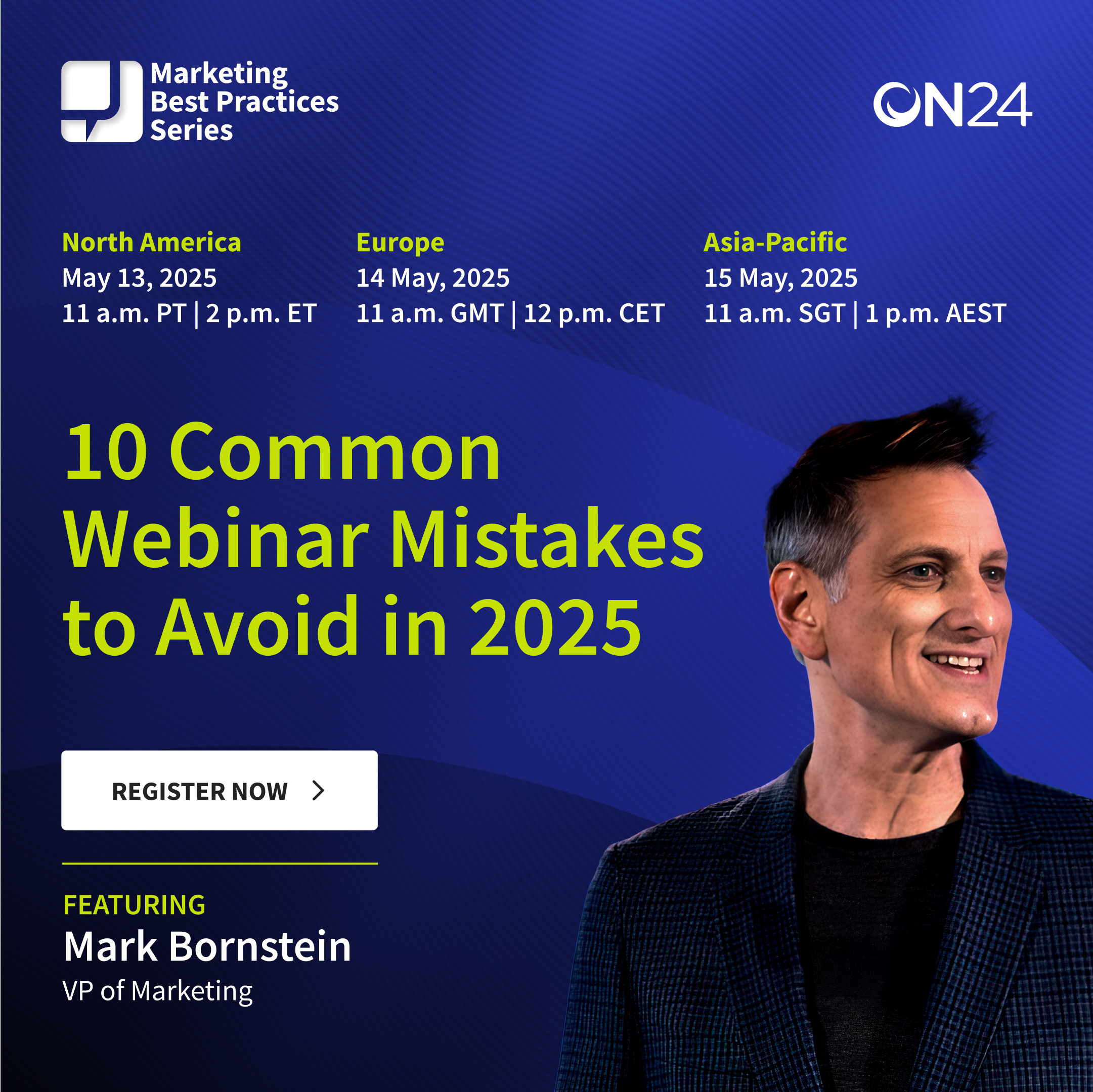10 Common Webinar Mistakes To Avoid

Webinars help generate pipeline, advance leads through the buying cycle, educate customers and prospects and much, much more. In a way, they’re the trusty Swiss Army Knife tool nearly every marketer requires.
Like any tool, however, a webinar is only as effective as the person(s) using it. And if you’re using webinars, whether to generate leads, drive engagement or contribute to growth, you’re bound to, well, make some mistakes.
Don’t worry, though! We’ve collected 10 of the most common webinar mistakes we’ve seen and put together a few remedies you can use to take your webinar program to the next level.
Let’s get started.
Mistake 1: Hoping for the best with your webinars

We know marketers find webinars useful. They help drive pipeline growth and marketing KPIs and are often one of the top-performing channels marketers use.
But one mistake we often see with webi-newbies is simply hoping they’ll see success by acquiring a webinar solution and, well, hoping. They don’t apply goals to their webinar program and are often unsure which metrics to measure and why.
You can’t prove your webinar program’s success without first knowing where you are and where you’re trying to take your program. Are you looking to improve audience? Then focus your optimization efforts on the average time spent in an event. Pipeline? Focus on conversion rates.
The point is: don’t have a plan to hope for the best. Instead, some targets should be developed based on business objectives and worked towards through optimization.
Unsure of where to start? Our latest Digital Engagement Benchmarks report can point you in the right direction.
Mistake 2: Sending cold leads to sales

Webinars are great at helping you understand who your audience is and what they want from you. They’re great at this because they empower audiences to engage with your brand, providing your team with crucial first-party data and insights.
But too often, those insights are left dormant or unused because they aren’t analyzed and shared with sales teams fast enough or are shared without a plan in place.
Don’t send useless webinar leads to sales. Instead, work with your sales team on an action plan ahead of the event. Check to make sure both marketing and sales teams have a clear understanding of what a warm or hot lead looks like. This will help sales to prioritize outreach.
Also, make sure your webinar solution is set up to share lead information with sales in near real-time. Often, that will mean integrating your webinar platform with a CRM, like Salesforce. With a quick handoff of qualified leads, your sales team will be set up for better conversations.
Mistake 3: Overreliance on e-mail promotions

Emails are not enough anymore. Your target audience’s attention is spread across a litany of different channels — team messaging, paid advertising, social media, search and more — and for successful webinar promotion, you need to reach them where they are.
Think about how you can cross-promote your webinars across multiple channels: social and email signatures work, sure. But so do banners on your homepage, CTAs in a digital resource center, content hubs, chatbots, customer community, channel partners — really, anywhere you can think of.
This isn’t to say you should start ignoring emails. Rather, you need to start developing a more comprehensive promotional strategy and testing various messaging across different channels.
For example, with generative AI, you can use an event abstract to draft email variations you can use in your promotions. You can even reuse that content across homepage banners social media and other channels.
And don’t forget to start promotions early. According to our latest Digital Engagement Benchmarks Report, audiences usually begin to register for webinars more than three weeks in advance.
Mistake 4: Engaging everyone the same

Webinars give you a unique opportunity to get to know your audience and make your brand more relatable. But engaging in broad strokes — treating every webinar and attendee the same — is a mistake.
Think about how you can segment and personalize your audience across your webinar program. Can you make different webinars for different segments? How about personalizing CTAs — even content — within a webinar to different audiences?
Implementing an audience-specific engagement strategy isn’t as hard as you may think. After all, the wealth of data you can capture during a webinar can tell you which segments respond best to which offers and which topics your audience cohorts care about the most.
Mistake 5: Treating webinars like a conference call

This may come as no small surprise, but webinars are meant to be engaging experiences. They are not, as many assume, meeting tools or glorified digital conference calls.
In fact, according to an IDC report on virtual events, today’s digital-first audiences expect to be able to participate in experiences, ask questions and self-explore content on their terms. Your responsibility with your webinar program is to meet those expectations.
One way to prime your audience for engagement is to slow down and clearly explain how they can participate during a webinar. This can be done several ways, through speaker direction, integrating a housekeeping video or adding directional signage into the webinar event branding.
Mistake 6: Forgetting to collect intent data

Do you think webinars are just barebones presentations? Simple events where you get to have your say and move on? Wrong.
Webinars are a two-way engagement street: your brand starts a conversation with attendees — often on a topic your brand is knowledgable about — and, in return, attendees share buying signals about their intent.
You need to collect and pay attention to this intent data. They’re important for your webinar program and your business.
For example, in a signal webinar, attendees can provide you with insights into buying intent, customer satisfaction and audience interest. These insights can accelerate deals, provide NPS scores, or book demos. With the right signals, you can empower your marketing, sales and customer success teams equally.
Mistake 7: Lacking an on-demand webinar strategy

Okay, so you’ve run your webinar and you’re sharing your results with sales. It’s over now right? Wrong. Webinars don’t end after a live production. If anything, on-demand webinars are just as important element in your program as the live event.
With on-demand webinars you can broaden your audience and cement your company as a proactive thought leader. How? Well, you can build out a webinar series, organize on-demand events by topic and even use them to provide a continuing education course. Really, it’s up to you.
Mistake 8: Forgetting to repurpose webinar content

Marketers are always looking for more content. More content means more opportunities to connect with different audiences at different stages of the buying journey and build brand reputation on different channels.
But creating great, unique content that resonates with audiences takes time, energy and resources. This is why it’s a mistake for content marketers to think of webinars as a one-off asset to be produced once and never used again. Webinars, it turns out, are a fantastic content engine.
With one webinar transcript, you can use generative AI to transform your event into content like blog drafts, e-books, and key summaries, and your content marketing team can quickly perfect and promote. You can also use webinar engagement analytics to identify key moments in your event and automatically produce video clips you can use on social media channels and personalized nurture pages.
The best part? With a strong content repurposing strategy, you can plan all of this in advance and easily stand up scalable, personalizable marketing campaigns. So, start repurposing your webinars!
Mistake 9: Treating no-shows as no-goes

Every event has its no-shows. But a no-show doesn’t mean no interest. And if you’re not engaging your would-be attendees, whether with on-demand recordings, content offers or recaps, you’re making a pretty big mistake.
Before your webinar begins, during your webinar planning stage, make sure your team has a follow-up and nurture strategy in place for no-shows. The simple, “We’re sorry we missed you” email isn’t enough.
For example, if a registrant expresses interest in your webinar’s topic, you can deliver additional, relevant content in different formats. Use key takeaways to summarize the missed event. Provide blog posts and e-books to expand on facets of your webinar. Produce content hubs that cover the subject holistically.
The point is that you have enough information and content to engage missed opportunities. Don’t allow yourself to miss out on them again.
Mistake 10: Adopting a set-it-and-forget-it webinar mentality

Webinars and virtual events are a reliable and top-producing channel for B2B marketers, with a solid position in a successful marketing mix. Now, with new AI innovations and the latest technologies, there’s an opportunity to build on that momentum and produce even greater results by reimagining your webinars.
Bonus Tips
Why stop at only 10? Here are a few additional, and common, webinar mistakes to keep in mind as you produce your events:
Repeating Yourself, Repeating Yourself, Repeating Yourself
Webinars need promoting and that means emails — a lot of emails. Unfortunately, a lot of organizations believe an email copy is an exercise in repetition and will send you the same email several times while expecting a different result. Einstein had something to say about that – and it’s something that is going to put customers off.
Instead of sending the same email over and over again, vary its message and vary where the reader is in the sign-up cycle. For example, you can give a high-level overview of an upcoming webinar during your first email send and a personal message from your presenter for the second send. Your third and fourth emails should address audiences who are “on the fence” — those who’ve clicked through an email but haven’t registered yet — shortly before a webinar takes place.
Plain Webinar Consoles
It’s not the 1990s anymore, so basic grey backgrounds and dated-looking webinar consoles aren’t going to cut it. Plain webinar consoles are just that: dull looking, basic and about as interesting as interacting with as a damp cloth. Change it up and make your consoles something your audience looks forward to.
Designing a good console isn’t as hard as it sounds. If your organization has brand guidelines (and it should) a simple solution would be to grab your brand logo, grab your brand colors and create a console based on those two elements. Another simple technique would be to grab any company imagery — so long as it’s not distracting — and use that as your webinar console. Whatever you do, just don’t make it boring.
Toxic Slides
Speaking of design. If you’re using slides during your webinar — and the vast majority of you are — make sure they, like your console, aren’t boring or toxic. What does this mean? Well, we mean slides that have too much text, slides that have fonts that are far too small and slides that have more design elements in it than a reasonable person can process.
What’s the secret to detoxifying your webinar slides? Simple. Use fewer. In fact, the main element of any webinar should be the presenter and what they have to say — not the slides. If you use slides, they should be easy to read or contain a single image for the presenter to talk to. Remember: attendees want to hear what you have to say — not interpret your slides.
Panic
Tripping over a few words in front of a crowd isn’t great. But not being able to recenter yourself and move on is worse. You get a shot of adrenaline and things spiral out of control from there. Panic is a common mistake when it comes to presenting a webinar and, really, any type of public speaking. It’s so common it even has a name: cognitive tunneling.
Cognitive tunneling is a common phenomenon where our attention, as a speaker or presenter, is funneled away from where it should be and towards whatever our brain fixates on. As Charles Duhigg describes it in his 2016 book, “Better Faster Smarter: The Transformative Power of Real Productivity,” cognitive tunneling is “a mental glitch that sometimes occurs when our brains are forced to transition abruptly from relaxed automation to panicked attention.”
The key to avoiding a panic-induced breakdown is simple: recognizing it when it happens, taking a breath and moving on. But that’s not always easy to do. Don’t try to hide it if you find yourself in a moment of panic or get locked up during a presentation. Instead, address the issue and move on. Your audience will understand. After all, they’re human too.
Get Ready to Propel Webinar Engagement
Today, if you’re using the right platform, you have the power to think of webinars as an unlimited canvas of possibilities, whether that’s delivering new formats, trying new ways to interact with your audience or using new technologies to reshape what a webinar can be. Now is the time to change how you engage!
Start innovating your webinars channel by building an experimentation roadmap that considers the new technologies available. Alongside that, think about different webinar types for new applications and goals.
It’s easy to make a webinar mistake, but it’s even easier to correct that mistake. Take the time to sit down and think through your webinar marketing strategy and act on your plan. Good luck!

